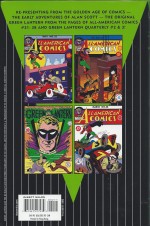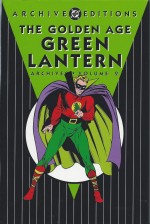

By Bill Finger, Martin Nodell & Irwin Hasen (DC Comics)
ISBN: 978-1-56389-794-8
Following the invention of the superhero genre and the early innovations in Superman and Batman at DC/National Comics, an avalanche of costumed crusaders erupted onto the nation’s newsstands. At the head of that gaudy tidal wave, thanks to innovative publisher Max Gaines and his comics mastermind Editor Sheldon Mayer, All American Comics (who co-published in association with and were eventually absorbed by DC) produced many of the new industry’s greatest and most memorable characters.
Most prominent was the first comicbook super-speedster who took off in Flash Comics (which also featured Hawkman and Johnny Thunder), followed a few months later by evergreen, immortal Green Lantern, the world’s original superhero coalition in the Justice Society of America, capped by the creation of the greatest female hero of all time – Wonder Woman.
Superman started the ball rolling and was the undisputed star of the medium, but the editors at All American truly understood it and the wide-eyed readership…
The Emerald Avenger debuted in the sixteenth issue of the company’s flagship title All-American Comics, just as superheroes started to dominate, supplanting newspaper strip reprints and stock genre characters in the still primarily-anthologised comicbooks.
For the duration of the war and a few years beyond it, GL and his mystery man amigos Red Tornado, The Atom, Sargon the Sorcerer and Doctor Mid-Nite stole the show with only celebrated gag-strip Mutt and Jeff or exceptional military strips Hop Harrigan and Red, White and Blue remaining to represent merely mortal stars.
All too soon, however, they would vanish as tastes changed and costumed champions were superseded by cowboys, cops and private detectives…
Devised by up-and-coming cartoonist Martin Nodell (and fleshed out by the incredible Bill Finger in the same way he had contributed to the success of Batman), Green Lantern became AA’s second smash sensation six months after The Flash and preceding by a year and a half the unprecedented success of the Amazing Amazon.
He won his own solo-starring title less than a year after his premiere and feature-starred in many anthologies such as Comics Cavalcade and All Star Comics for just over a decade, before he too faded away in the early1950s, having first suffered the humiliating fate of being edged out of his own comicbook by his pet, Streak the Wonder Dog…
This second engagingly impressive hardcover Archive edition – collecting the Viridian Vigilante’s appearances from Green Lantern Quarterly #2-3 (Winter and Spring 1942) and All-American Comics #31-38, from October 1941 to May 1942 – opens with rousing reminiscences, intriguing comparisons and tantalising trivia titbits, courtesy of the Foreword by godfather of American fandom Dr. Jerry Bails, before the procession of pictorial peril begins…
Ambitious young engineer Alan Scott survived the sabotage and destruction of a passenger-packed train due only to the intervention of a battered old railway lantern. Bathed in its eerie verdant glow, he was regaled by a mysterious green voice with the legend of how a meteor fell in ancient China and spoke to the people: predicting Death, Life and Power.
After bringing doom to the mystic who reshaped it into a lamp and, centuries later, sanity to a madman, it now promised incredible might to bestow justice to the innocent. Instructing the engineer to fashion a ring from its metal and draw a charge of power from the lantern every 24 hours, the ancient artefact urged the engineer to use his formidable willpower to end all evil – a mission Scott eagerly embraced…
The ring made him immune to all minerals and metals, and enabled him to fly and pass through solid matter amongst many other miracles, but was powerless against certain organic materials such as wood or rubber which could penetrate his jade defences and cause him mortal harm…
After wandering the country for months, Scott eventually settled in Capitol City and took a job as first engineer and eventually radio announcer at the APEX Broadcasting System whilst he fruitlessly pursued feisty reporter Irene Miller. Before long he even had a trusted sidekick in the flabby form of Doiby Dickles, a rotund, middle-aged Brooklyn-born cab driver originally intended as a light foil for the grim, poker-faced Emerald Avenger.
Soon, however, the bumbling buddy grew to be one of the most popular and beloved comedy stooges of the era; sharing covers and even by-lines with the star who, thanks to scripter Finger (who wrote all the stories in this volume), was a grim, brooding and spookily mysterious figure of vengeance weeding out criminals and gangsters. Moreover, just as with the early Batman sagas, there was always a strong undercurrent of social realism, ballsy sentimentality and human drama.
The action starts with All-American Comics #31’s ‘The Adventure of the Underfed Orphans!’ illustrated by Martin Nodell, wherein Alan and Irene investigate food poisoning at a municipal children’s home, and uncover a shocking web of abuse and graft leading to the upper echelons of City Hall and the grimiest gutters of the underworld…
Most of the All-American GL tales were untitled such as #32, drawn by Irwin Hasen, which revealed how a veteran beat cop’s son fell in with the wrong crowd. Framed by his boss and arrested by his own dad, vengeful Danny was only stopped from ruining his life forever by the Emerald Avenger and Doiby who helped him get the goods on Gardenia and reconcile with his grateful dad.
The next issue (by Nodell) struck close to home as gangster Pug Deagan tried to take over the Taxicab Drivers’ union and Doiby called on his Grim Green friend to clean up the racket and expose the real brain behind the operation, whilst in All-American #34, the Dynamic Trio of Alan, Irene and Mr. Dickles investigated a collapsing building and were drawn into a colossal construction scandal involving the Mayor, culminating in the horrific failure of Capitol City’s biggest and busiest bridge.
Always one of the most powerful characters in comics, this tale especially demonstrated the sheer scope of Green Lantern’s might…
All-American Comics #35 found Doiby wracked by toothache and haplessly stumbling into a grisly murder at the dentist’s office. Once again racketeers were trying to take over a union and only GL and Dickles could stop them. That tale concluded with the cabbie having that tooth punched out and learning the secret of Alan Scott – an even bigger shock!
A huge hit from the start, the Emerald Crusader was fast-tracked into his own solo title, where the creators were encouraged to experiment with format. Green Lantern Quarterly #2 was cover-dated Winter 1942 and offered ‘The Tycoon’s Legacy’ by Finger & Nodell: a 4-chapter “novel-length story†which saw radio engineer Scott promoted to roving man-with-a-microphone, promptly rushing to the assistance of a poor but honest lawyer and a porter swindled out of a five million dollar bequest. Both cases deliciously intertwined like a movie melodrama, and also saw a framed man freed from the asylum to challenge the swindling estate executors who had trapped him there.
Events took a murderous turn just as Alan’s emerald alter ego got involved, and before long Green Lantern was cracking heads and taking names in the hunt for the mastermind behind it all – a man known only as ‘Baldy’…
Bill Finger was a master of this type of socially redeeming mystery thriller, and the unrepentant fan in me can’t help but wonder what he could have accomplished with such a prodigious page count on his other “Dark Avenger†assignment Batman and Robin…
Hasen illustrated the remaining All-American yarns in this collection, beginning with #36 (March 1942) which took GL and Doiby to the motor racing circuit to foil the machinations of mobsters murdering drivers of a new type of car. With no clue as to how the killings were accomplished, Doiby volunteered to drive the ill-fated Benson Comet himself, trusting in his pal “Da Lantrin†to save the day as usual…
Issue #37 found the heroes helping a disgraced pilot whose crashed plane cost America its greatest scientific minds. A closer investigation revealed not only Fog Blake‘s innocence but that the Brain Trust had been cunningly abducted by Nazi agents… but not for long, after which issue #38 pitted the Emerald Guardian against a diminutive criminal strategist who organised America’s gangs like ‘Another Napoleon’ before facing his own Waterloo in a blaze of green light…
With America freshly put on an all-encompassing war-footing, superheroes at last tackled the world’s latest monsters full-on, and with great verve and enthusiasm this blistering compilation concludes in another novel-length epic from the third Green Lantern Quarterly deliciously crafted by Finger & Nodell.
It begins with ‘The Living Graveyard of the Sea’ as Alan and Irene (and stowaway Doiby) take ship for Australia only to be torpedoed by a gigantic German super U-Boat. Although Green Lantern fights off the air and sea assault the liner is lost. The survivors take to life boats and the one with Doiby, Irene and Alan is drawn into a vast impenetrable fog-bank…
The clouds conceal an ancient wonder: a Sargasso Sea enclave of mariners from many eras who have, over the centuries, evolved into a truly egalitarian, pacifist society. However the lifeboat contains a cross-section of modern America, all horribly infected with greed, pride, arrogance and prejudice and, although welcomed, the newcomers soon disrupt the idyllic microcosm.
Things take an even worse turn when another U-Boat surfaces within the sea city and fanatical Kapitan Schmidt attempts to annexe the realm and convert the ancients to ‘The Nazi Dream’. The stakes are raised even further when he finally gets a message through to Berlin and Hitler himself demands that the strategically crucial secret island be taken at all costs…
The fantastic finale comes as Irene and Doiby redeem their selfish fellow Americans and rouse the calmly neutral Sargasso citizens to fight for freedom and liberty in ‘Utopia vs. Totalitarianism’ whilst all Green Lantern has to do is sink the entire Nazi naval and aerial armada tasked with taking the hidden sea world…
I sometimes think – like many others I know – that superhero comics were never more apt or effective than when they were whole-heartedly combating fascism with explosive, improbable excitement and mysterious masked marvel men.
The most satisfyingly evocative and visceral moments of the genre all seem to come when gaudy gladiators soundly thrashed – and please forgive the contemporary offensive colloquialism – “Nips and Nazisâ€, and the staggering denouement depicted here is one of the most expansive and breathtaking ever seen…
Complete with the stellar covers by Nodell & Hasen, this riotous vintage assembly of classic Fights ‘n’ Tights fare is enthralling, engrossing and overwhelmingly addictive – even if not to every modern fan’s taste – and no lover of Costumed Dramas can afford to miss out on the fun …
© 1941, 1942, 2002 DC Comics. All Rights Reserved.
